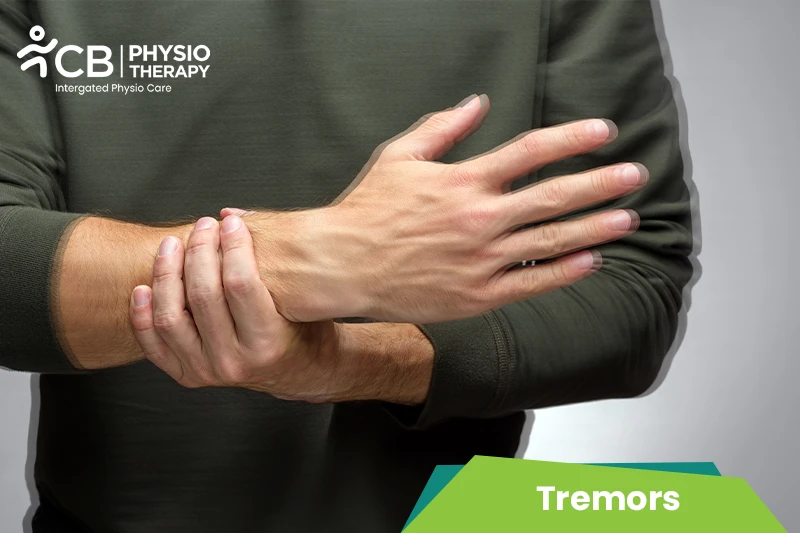
Tremors are involuntary movements of a part or parts of the body, occurring at a slow frequency of about 4 – 7 oscillations per second. These movements lead to shaking, back and forth oscillatory movements. It is the most common movement disorder. Tremors are not life-threatening but they can be embarrassing and disabling.
· Resting tremors:
Typically present at rest and disappears with voluntary movements. Resting tremors may be seen in hands, legs, feet, lips, tongue, and jaws.
· Action tremors:
Occur during movement of the affected part.
Types of Action tremors
Kinetic tremors
Occur when a person is in the process of voluntary muscle contraction, such as reaching for something and suddenly the handshakes.
Intentional tremors
Occurs while specific functional skills such as writing, feeding, and dressing.
Postural tremors
During sitting or standing, when a limb or body is supported against gravity.
Orthostatic tremors
Occur while standing, the legs and trunk shakes and stops when a person starts moving.
· Shaking hands, arms, feet, legs, tongue.
· Difficulty in feeding, writing and dressing.
· Shaky voice.
· Difficulty in holding things.
· Difficulty in walking.
There are various reasons for a person to have tremors, it can be just physiological when a normal person stretches the hand and keeps it steady you can see some amount of shaking and this can get exaggerated when you are anxious or stressed. It can be associated with neurological disorders like
· Stroke
· Peripheral neuropathy
· Traumatic brain injury
· Wilson’s disease
The other causes can be
· Drug induced anti-depressants, amphetamines, caffeine, corticosteroids, etc.
· Genetic.
· Alcohol abuse.
· Liver or kidney failure.
· High blood sugar.
· Aging.
· Stress or anxiety.
· Electromyogram or EMG.
The test measures involuntary muscle activity and muscle response to nerve stimulation
Accelerometer
Used to check the speed of the tremors, which are classified as low frequency (< 4Hz ), moderate frequency ( 4- 7 Hz) and high frequency ( > 7 Hz).
Physical examination
· History and complete neurological examination helps the therapist to access the tremors. During a physical examination your therapist observes and does some neurological examinations like:
· Ability to feel touch
· Muscle tone
· Tendon reflexes
The patient is asked to perform certain tasks
· Observe the patient at rest.
· Ask the patient to extend arms and hold.
· Finger nose test
· Heel to shin test
Medication
Tranquilizers, anti- seizures, Beta-blockers (should be taken as prescribed by the doctor)
Physiotherapy treatment for Tremors
Physiotherapy helps to bring people from a state of disability to a good functional status. It helps to strengthen your muscles and improve the coordination. It improves balance, gait, flexibility and grip strength
Physiotherapy uses the following techniques:
Relaxation exercises
Gentle rocking, rotational exercises combined with deep breathing can be used to produce generalized relaxation. Range of motion exercises should be emphasized for restoring range of motion of neck and trunk and can be performed in combination with rotational exercises to promote relaxation.
Exercises should initially be performed in fully supported positions like supine - slow side to side head rotations, hook lying - lower trunk rotations, side-lying - upper and lower trunk rotations.
PNF technique
Proprioceptive neuromuscular facilitation progressive movements from passive to active assisted to slightly resisted or active movement, which is designed to overcome the crippling effects of mobility. Techniques like hold relax, contract-relax techniques are used as a treatment technique.
Flexibility exercises
Both active and passive ROM exercises are used to improve flexibility. Exercises emphasize active motions that are performed two or three times a day. Exercise should be focused on strengthening the patient’s weak, elongated extensor muscles and tight flexor muscles.
Stretching techniques
This technique can be used to elongate the muscles. The patient or caregiver should be instructed on appropriate stretching exercises and the importance of maintaining the stretch force for at least 15 – 30 seconds. Stretches are repeated at least 3 -5 times. Ballistic stretches (high-intensity bouncing stretches) should be avoided.
Mobility exercises
The overall focus is on improving mobility and function with specific emphasize on improving segmental mobility of the head, trunk and proximal segments hips and shoulders the movements should be rhythmic and should progress towards increasing ROM. Bed mobility , sitting and standing activities are essential skills to be taught.
Balance activities
A number of positions can be used to improve balance. Training should begin with weight shifts in both sitting and standing positions. The complexity of the activities can be altered by increasing the range of the weight shift or adding upper extremity tasks like reaching, picking up objects off the floor, tying shoelaces etc. Use of Swiss ball can be incorporated also.
Home program
Early morning warm-up exercises are helpful in the morning reduces morning stiffness. HOM exercises can often be assisted by the use of adaptive equipments like wall pulleys, which can be used to improve upper extremities ROM. Hanging from an overhead bar, maintain the stretch to upper extremities, wands or canes can used in promoting overhead movements. In standing countertop or sturdy chair can be used to assist in stabilization during balance activities.
Patient and family education
Patients, family members and caregivers need to be educated about the patient’s condition. They should be taught to understand the preventive measures taken to minimize the secondary complications and impairments that typically result. The patient cannot be hurried because performance will suffer. Caregivers should be encouraged not to provide too much assistance because this will foster dependence.
Select your City to find & connect with our experts regarding Physiotherapy for Tremors